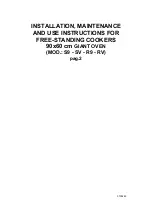
5. C
OMBUSTION
A
IR
M
OTOR
(F
AN
)
AND
/
OR
C
OMBUSTION
A
IR
D
AMPER
M
OTOR
I
NOPERATIVE
Check the fuse and high limit thermostat. The combustion air fan (12)
and the Combustion Air Damper Motor (13) are energized when the unit is in
either the “COOK”, “COOK and HOLD”, or “EVAC” modes and the
appropriate thermostat is calling for a temperature increase (recall the 60
second delay for this fan after the thermostat contacts close). If the
combustion air damper actuator is energized (i.e. the damper is open) and
the wiring to the combustion air fan is OK, then replace the fan. If the
reverse is true, then check the Combustion Air Damper Motor and replace if
defective.
If both are inoperative check for proper voltage at terminal 3 of the
Combustion Air Delay Timer (13A). If voltage is proper and neutral
continuity is verified at the Combustion Air Fan and the Combustion Air
Damper Motor then replace both components. If the voltage is not OK then
check for proper voltage between terminals 2 and 7 of the Combustion Air
Delay Timer. If the voltage there is OK then replace it. If not OK then check
the thermostat for proper voltage and replace/repair as needed.
6. H
EATER
E
LEMENT
I
NOPERATIVE
First verify that a thermostat is calling for a temperature rise and that
the heater element switch is on. Next check the fuse and high limit
thermostat. Check the voltage between terminals 4 and 8 of the Heater
Element Relay (27A). If OK and if the wiring between the Heater Element
Relay and the Heater Element (27) is OK then replace the heater element. If
the voltage between terminals 4 and 8 is not OK, then trace the circuit
rearward to find the problem.
7. EVAC D
AMPER
M
OTOR
I
NOPERATIVE
Check the fuse and high limit thermostat. Check for proper voltage at
terminal 4 of contact block A on the EVAC Switch (3). If voltage is OK and
the wiring is OK between the switch and the EVAC Damper Motor (15) then
the damper motor may need to be replaced. First, however, verify that the
damper motor has not just overheated. This damper motor has an internal
limit switch – it must be allowed to complete its power stroke and close its
limit switch contacts. Otherwise, it will overheat, trip out internally and
then eventually fail completely. When adjusting linkages always let the
motor complete its power stroke (amperage then drops to about 0.2) before
connecting any load to the pivoting arm. If voltage at terminal 4 is not OK
then trace the circuit rearward to find the problem.
8. F
LUE
D
AMPER
M
OTOR
I
NOPERATIVE
Use the same procedure as for the EVAC Damper motor except verify
the voltage at terminal 4 of contact block B of the EVAC switch.
Page 15 of 43
Содержание 250R-FS
Страница 2: ...SN _______________ ...
Страница 6: ......
Страница 8: ......
Страница 28: ...RE SET HERE RESETTING OVERLOADS Page 20 of 43 ...
Страница 30: ...Page 22 of 43 ...
Страница 31: ...37 39 38 FIREBOX DOOR 27 26 INTERIOR VIEW COWLING REMOVED 25B Page 23 of 43 ...
Страница 32: ...Page 24 of 43 ...
Страница 34: ...Page 26 of 43 ...
Страница 36: ...Page 28 of 43 ...
Страница 38: ...Page 30 of 43 ...
Страница 39: ...Page 31 of 43 ...
Страница 40: ...Page 32 of 43 ...
Страница 41: ...Page 33 of 43 ...
Страница 42: ...Page 34 of 43 ...
Страница 43: ... Page 35 of 43 ...
Страница 44: ... lJD Page 36 of 43 ...
Страница 45: ...Page 37 of 43 ...
Страница 46: ...Page 38 of 43 ...
Страница 47: ...Page 39 of 43 ...
Страница 48: ...Page 40 of 43 ...
Страница 52: ......
















































